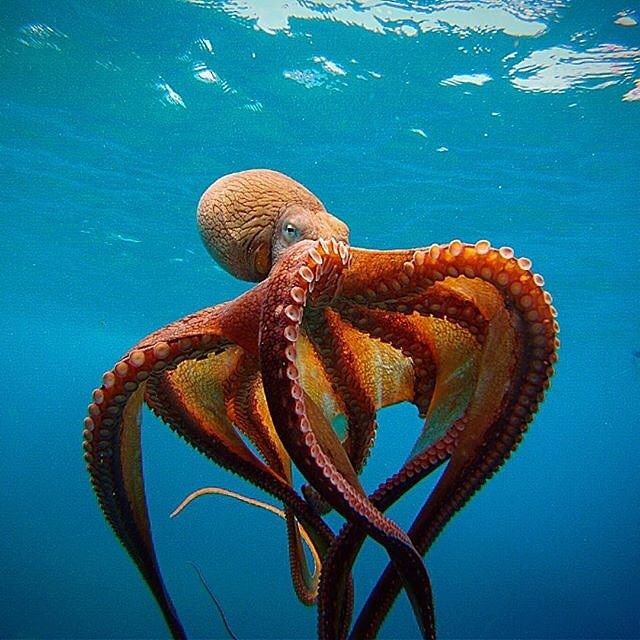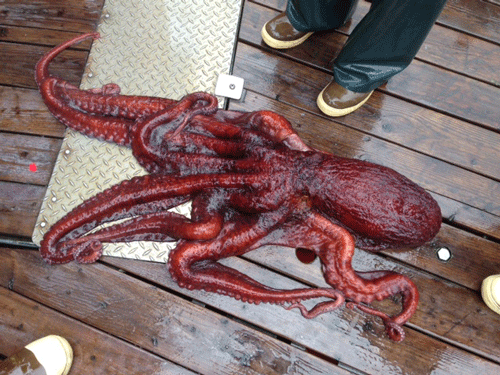Types of Octopus Species
14 Fascinating Octopus Species from Around the World
Introduction:
The world beneath the waves is a realm of incredible diversity, and few creatures capture the imagination quite like octopuses. These intelligent and adaptable cephalopods come in a stunning array of forms, each species showcasing its own unique traits and behaviors. In this journey into the depths, we’ll delve into the captivating world of 14 distinct octopus species, each with its own story to tell.
Here are 14 types of octopus mentioned:
- Common Octopus
- Giant Pacific Octopus
- Blue-Ringed Octopus
- Mimic Octopus
- Coconut Octopus
- Dumbo Octopus
- Day Octopus
- Hairy Octopus
- Blanket Octopus
- Alaskan Giant Octopus
- Flamboyant Cuttlefish
- Atlantic Pygmy Octopus
- Southern Blue-Ringed Octopus
- Veined Octopus

Common Octopus
The Common Octopus, found in the Atlantic and Mediterranean, serves as our starting point. Renowned for its problem-solving skills and remarkable ability to blend into its surroundings through camouflage, this species sets the stage for our exploration.

Giant Pacific Octopus
Venturing to the Pacific coast of North America, we encounter the Giant Pacific Octopus, a true behemoth of the octopus world. Its impressive size and intelligent behavior have captured the attention of researchers and enthusiasts alike.

Blue-Ringed Octopus
From size to venom, the Blue-Ringed Octopus is a testament to nature’s delicate balance between beauty and danger. Discovered in the Pacific and Indian Oceans, these tiny creatures command respect with their vibrant blue rings and potent toxins.


Mimic Octopus
Meet the ultimate master of disguise. The Mimic Octopus, hailing from the Indo-Pacific region, showcases an astonishing ability to imitate other marine species, a trick it employs to confound predators and captivate observers.

Coconut Octopus
In the warm waters of the Indo-Pacific, the Coconut Octopus stands out for its resourcefulness. Using coconut shells and debris for shelter, it offers a glimpse into the creative adaptations that thrive beneath the waves.

Dumbo Octopus
Venturing into the deep sea, we encounter the enchanting Dumbo Octopus. Its graceful fins resemble the ears of Disney’s beloved character, Dumbo, as it navigates the abyssal depths with otherworldly elegance.

Day Octopus
Amidst the sunlit shallows of the Indo-Pacific, the Day Octopus dazzles with its intricate patterns and vibrant colors. Active during daylight hours, it presents a captivating display of behaviors under the watchful gaze of the sun.

Hairy Octopus
Delve into the intricate world of the Hairy Octopus, adorned with peculiar hair-like structures. This adaptation aids in its camouflage, allowing it to seamlessly blend into the seabed and avoid prying eyes.

Blanket Octopus
In the open oceans, the Blanket Octopus takes center stage. The female’s stunning display of unfurling a web-like membrane serves as a visual deterrent to potential threats, making it a true marvel of ocean defense mechanisms.


Alaskan Giant Octopus
Similar to its cousin, the Giant Pacific Octopus, the Alaskan Giant Octopus calls the northern Pacific Ocean home. Its mysterious allure and impressive size contribute to the tapestry of marine wonders.

Flamboyant Cuttlefish
Though not an octopus, the Flamboyant Cuttlefish warrants inclusion for its captivating appearance and unique locomotion. Found in the Indo-Pacific, its vibrant colors and mesmerizing movements are a spectacle to behold.

Atlantic Pygmy Octopus
The Atlantic Pygmy Octopus, despite its small size, leaves a big impression. With a presence in the Western Atlantic, it offers a window into the diversity of octopus life across different oceans.

Southern Blue-Ringed Octopus
Venturing into the southern reaches of Australia and New Zealand, we encounter the Southern Blue-Ringed Octopus. A close relative of its more renowned counterpart, its unique habitat and behavior add depth to the story of blue-ringed octopuses.

Veined Octopus
Concluding our journey, the Veined Octopus showcases the artistry of nature once more. With its mastery of camouflage and habitat preferences in Southeast Asian waters, it serves as a testament to the subtle variations within octopus species.

“Did you know?”
Facts about octopuses:
| Fact | Description |
|---|---|
| Octopuses have three hearts | Octopuses possess three hearts: two pump blood to the gills for oxygenation, and one circulates oxygenated blood to the body. |
| Blue blood due to hemocyanin | Octopus blood is blue because of the presence of hemocyanin, a copper-based molecule that transports oxygen. |
| Remarkable camouflage abilities | Octopuses can change color and texture rapidly to blend into their surroundings, making them masters of camouflage. |
| Highly intelligent creatures | Octopuses exhibit advanced problem-solving skills and have been known to escape from enclosures in captivity. |
| Tentacles are equipped with suckers | Octopus tentacles are lined with suckers that have sensory abilities and can manipulate objects with precision. |
| Ink defense mechanism | When threatened, octopuses release a cloud of ink, which confuses predators and provides an opportunity for escape. |
| Complex nervous system | Octopuses have a decentralized nervous system, with neurons in their arms, allowing for independent movement and responsiveness. |
| Short lifespan | Most octopus species have relatively short lifespans, typically ranging from one to two years. |
| Capable of regenerating limbs | Octopuses can regrow lost limbs, which helps them recover from injuries and defend against predators. |
| Jet propulsion for movement | Octopuses move by expelling water from their bodies through a process called jet propulsion. |
Conclusion
The world’s oceans are teeming with life, and the realm of octopuses presents a vivid tapestry of diversity and adaptation. From the intricate patterns of the Day Octopus to the remarkable mimicry of the Mimic Octopus, each species invites us to explore the depths of their lives and habitats. These 14 species serve as ambassadors of the vast and often mysterious world that lies beneath the waves, reminding us of the wonders that continue to captivate scientists, divers, and enthusiasts alike.
5 thoughts on “Types of Octopus Species”
Hiya very nice website!! Guy .. Beautiful .. Wonderful .. I will bookmark your web site and take the feeds additionallyKI’m glad to seek out so many helpful info right here within the put up, we need develop extra techniques on this regard, thanks for sharing. . . . . .
very interesting points you have mentioned, appreciate it for putting up.
I do agree with all of the ideas you have presented in your post. They are very convincing and will certainly work. Still, the posts are too short for novices. Could you please extend them a little from next time? Thanks for the post.
How can I find out more about it?
I really like what you guys tend to be up too. This sort of clever work and coverage!
Keep up the superb works guys I’ve you guys to my own blogroll.